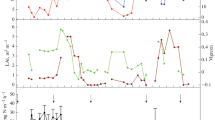Abstract
Nitrous oxide (N2O) emission from fertilized maize fields was measured using a closed chamber at four experimental sites in Thailand. The average measured N2O flux from unfertilized plots through crop season was 4.16 ± 1.52, 5.05 ± 1.65, 5.25 ± 1.68 and 6.74 ± 2.95 μg N2O-N m-2 h-1, at Nakhon Sawan, Phra Phutthabat, Khon Kaen and Chiang Mai, respectively. Increased N2O emissions by the application of nitrogen fertilizer were 0.22–0.44, 0.19–0.38%, 0.12–0.24 and 0.08–0.15% of the applied N, respectively. Compared to other data, N2O emission rate to applied nitrogen was not significantly different between the data of Thailand and the Temperate Zone.
Similar content being viewed by others
References
Bouman AF (1990) Exchange of greenhouse gases between terrestrial ecosystems and the atmosphere. In Bouman AF (ed) Soils and the Greenhouse Effects, pp 61–127 JohnWiley & Sons, New York
Bouman AF (1996) Direct emission of nitrous oxide from agricultural soils. Nutr Cycl Agroecosyst 46: 53–70
Bremner JM & Blackmer A M (1981) Terrestrial nitrification as a source of atmosphere nitrous oxide. In Delwiche CC (ed) Denitrification, nitrification and atmospheric N2O, pp 151–170. John Wiley & Sons Ltd., Chichester
Cicerone RJ (1989) Analysis of sources and sinks of atmospheric nitrous oxide (N2O). J Geophys Res 94: 18265–18271
Crutzen PJ (1971) Ozone production rates in oxygen-hydrogen-nitrogen oxide atmosphere. J Geophys Res 76: 7311–7327
Eicher MJ (1990) Nitrous oxide emissions from fertilized soils: Summary of available data. J Environ Qual 19: 272–290
FAO (1995) Fertilizer Year Book, FAO
IPCC (1995) Climate Change1994, In: Houghton JT, Meria Filho LG, Bruce J, Hoesung Lee, Callander BA, Haites E, Harris N & Maskell K (eds) pp 27–28, 90. Cambridge University Press, UK
Matson PA, Vitousek PM, Livingston GP & Swanberg NA (1990) Sources of variation in nitrous oxide flux from Amazonian ecosystems. J Geophys Res 95: 16789–16798
McTaggart IP & Smith KA (1996) Nitrous oxide emission from arable and grassland soils: Effect of crop type and nitrification inhibitors. Abstracts of 9th Nitrogen Workshop Braunschweig, Sept. 1996, pp 523–526
Minami K. Nitrous oxide emissions from agricultural fields. In Singh SN (ed) Climate Change and Plants, Springer-Verlag, in press
Mosier AR, Duxbury JM, Freney JR, Hienemeyer O & Minami K (1996) Nitrous oxide emissions from agricultural fields: Assessment, measurement and mitigation. Plant Soil 181: 95–108
Sanhueza E, Hao WM, Scharffe D, Donoso L & Crutzen PJ (1990) N2O and NO emissions from soils of the northern part of the Guayana Shield. Venezuela. J Geophys Res 95: 22481–22488
Author information
Authors and Affiliations
Corresponding author
Rights and permissions
About this article
Cite this article
Watanabe, T., Chairoj, P., Tsuruta, H. et al. Nitrous oxide emissions from fertilized upland fields in Thailand. Nutrient Cycling in Agroecosystems 57, 55–65 (2000). https://doi.org/10.1023/A:1009764421174
Issue Date:
DOI: https://doi.org/10.1023/A:1009764421174




